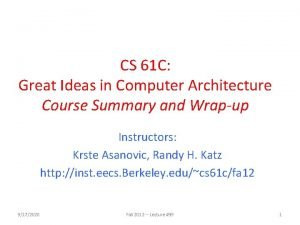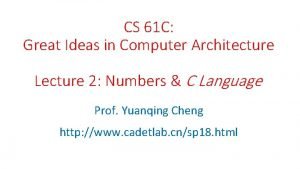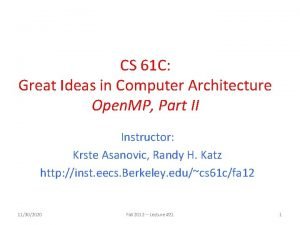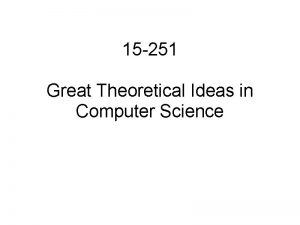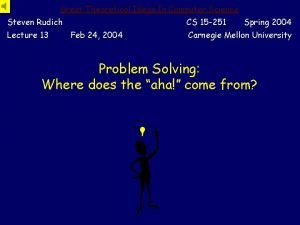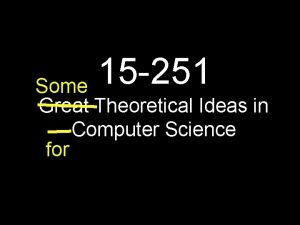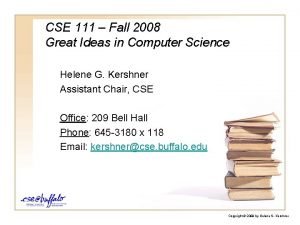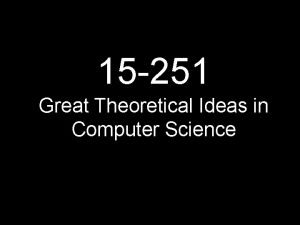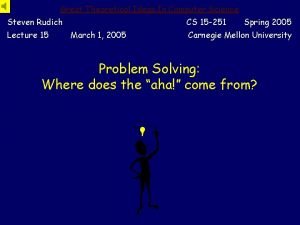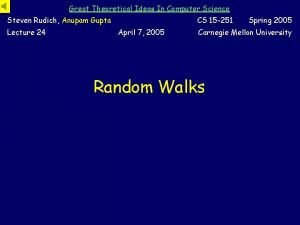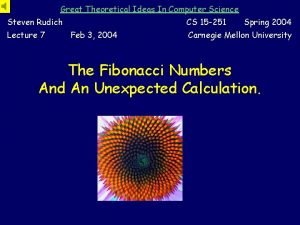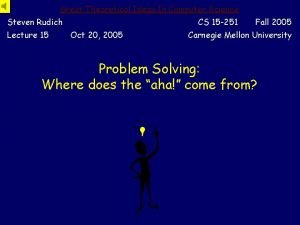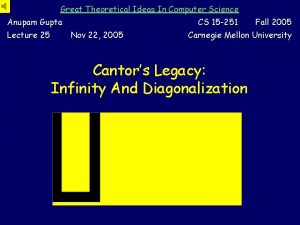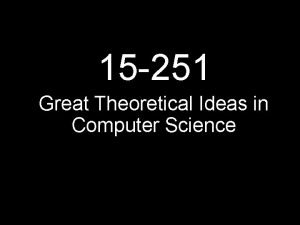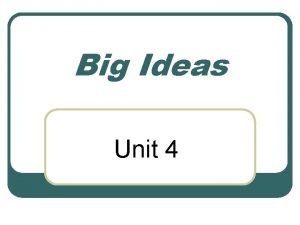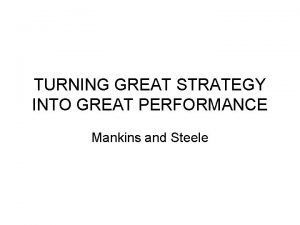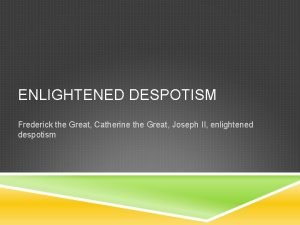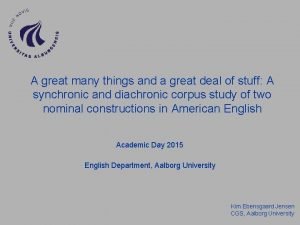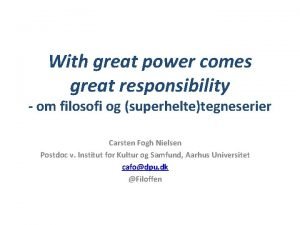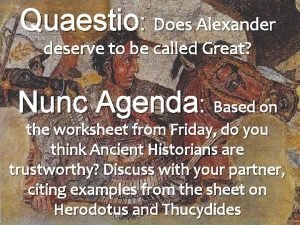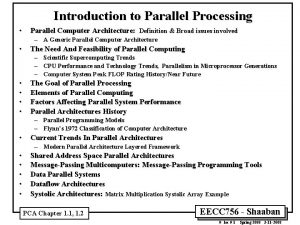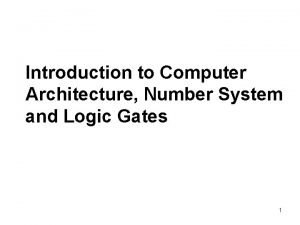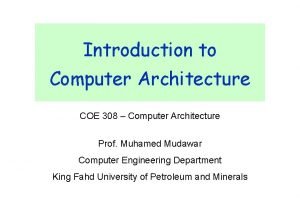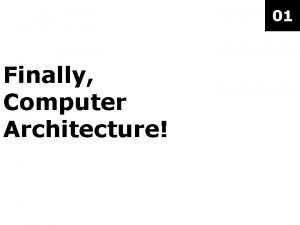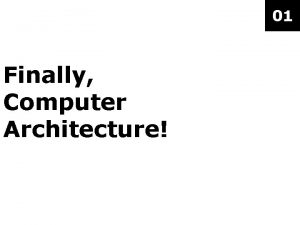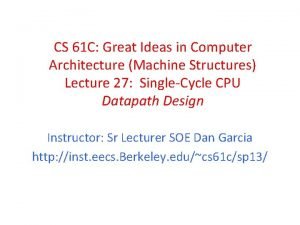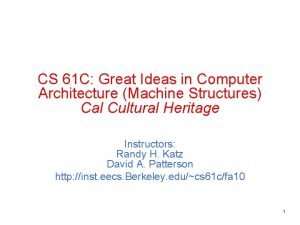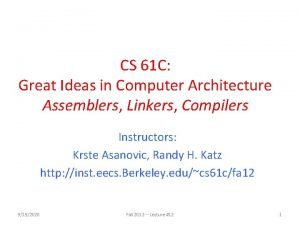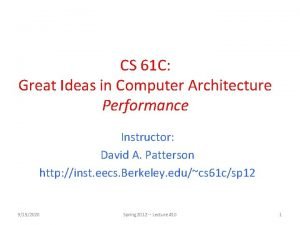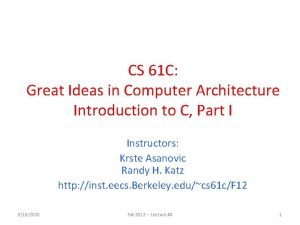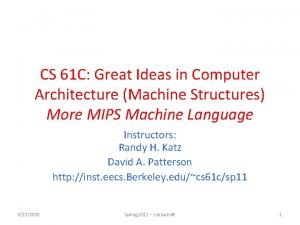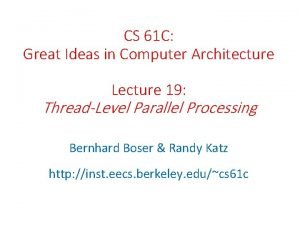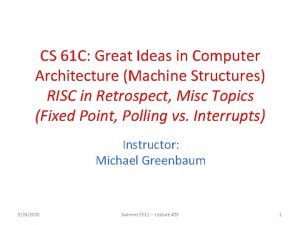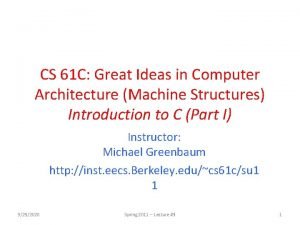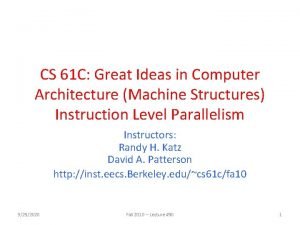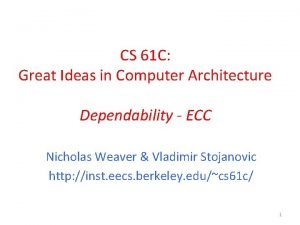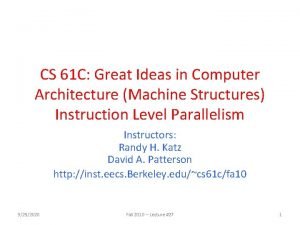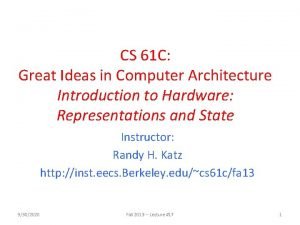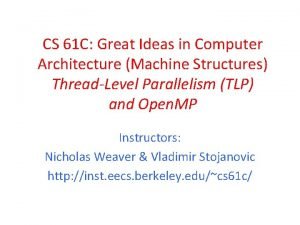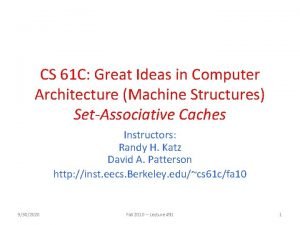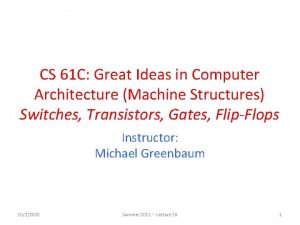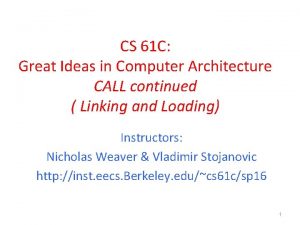CS 61 C Great Ideas in Computer Architecture















































![Simulator for Decode Phase Register 1 = Register[rsfield]; Register 2 = Register[rtfield]; if (opcode Simulator for Decode Phase Register 1 = Register[rsfield]; Register 2 = Register[rtfield]; if (opcode](https://slidetodoc.com/presentation_image_h/1ebb89c1639733a1f5fd7168df86c2eb/image-48.jpg)










- Slides: 58

CS 61 C: Great Ideas in Computer Architecture Compilers, Components Instructor: David A. Patterson http: //inst. eecs. Berkeley. edu/~cs 61 c/sp 12 3/2/2021 Spring 2012 -- Lecture #9 1

New-School Machine Structures (It’s a bit more complicated!) Software • Parallel Requests Assigned to computer e. g. , Search “Katz” • Parallel Threads Assigned to core e. g. , Lookup, Ads Hardware Harness Parallelism & Achieve High Performance Smart Phone Warehouse Scale Computer Today’s Lecture Computer • Parallel Instructions >1 instruction @ one time e. g. , 5 pipelined instructions • Parallel Data >1 data item @ one time e. g. , Add of 4 pairs of words • Hardware descriptions All gates @ one time • Programming Languages 3/2/2021 … Core Memory Core (Cache) Input/Output Instruction Unit(s) Core Functional Unit(s) A 0+B 0 A 1+B 1 A 2+B 2 A 3+B 3 Cache Memory Today’s Lecture Spring 2012 -- Lecture #9 Logic Gates 2

Levels of Representation/Interpretation. Today’s Lecture High Level Language Program (e. g. , C) Compiler Assembly Language Program (e. g. , MIPS) Assembler Machine Language Program (MIPS) temp = v[k]; v[k] = v[k+1]; v[k+1] = temp; lw lw sw sw 0000 1010 1100 0101 $t 0, 0($2) $t 1, 4($2) $t 1, 0($2) $t 0, 4($2) 1001 1111 0110 1000 1100 0101 1010 0000 Anything can be represented as a number, i. e. , data or instructions 0110 1000 1111 1001 1010 0000 0101 1100 1111 1000 0110 0101 1100 0000 1010 1000 0110 1001 1111 Machine Interpretation Hardware Architecture Description (e. g. , block diagrams) Architecture Implementation Logic Circuit Description 3/2/2021(Circuit Schematic Diagrams)Spring 2012 -- Lecture #9 3

Review • Everything is a (binary) number in a computer – Instructions and data; stored program concept • Assemblers can enhance machine instruction set to help assembly-language programmer • Translate from text that easy for programmers to understand into code that machine executes efficiently: Compilers, Assemblers • Linkers allow separate translation of modules • Interpreters for debugging, but slow execution • Hybrid (Java): Compiler + Interpreter to try to get best of both • Compiler Optimization to relieve programmer 3/2/2021 Spring 2012 -- Lecture #9 4

Agenda • Compilers, Optimization, Interpreters, Just-In. Time Compiler • Administrivia • Dynamic Linking • Technology Trends Revisited • Technology Break • Components of a Computer 3/2/2021 Spring 2012 -- Lecture #9 5

What is Typical Benefit of Compiler Optimization? • What is a typical program? • For now, try a toy program: Bubble. Sort. c 3/2/2021 #define ARRAY_SIZE 20000 int main() { int iarray[ARRAY_SIZE], x, y, holder; for(x = 0; x < ARRAY_SIZE; x++) for(y = 0; y < ARRAY_SIZE-1; y++) if(iarray[y] > iarray[y+1]) { holder = iarray[y+1]; iarray[y+1] = iarray[y]; iarray[y] = holder; } } Spring 2012 -- Lecture #9 6

Unoptimized MIPS Code $L 3: lw $2, 80016($sp) slt $3, $2, 20000 bne $3, $0, $L 6 j $L 4 $L 6: . set noreorder nop. set reorder sw $0, 80020($sp) $L 7: lw $2, 80020($sp) slt $3, $2, 19999 bne $3, $0, $L 10 j $L 5 $L 10: lw $2, 80020($sp) move $3, $2 sll $2, $3, 2 addu $3, $sp, 16 3/2/2021 addu $2, $3, $2 lw $4, 80020($sp) addu $3, $4, 1 move $4, $3 sll $3, $4, 2 addu $4, $sp, 16 addu $3, $4, $3 lw $2, 0($2) lw $3, 0($3) slt $2, $3, $2 beq $2, $0, $L 9 lw $3, 80020($sp) addu $2, $3, 1 move $3, $2 sll $2, $3, 2 addu $3, $sp, 16 addu $2, $3, $2 lw $3, 0($2) sw $3, 80024($sp lw $3, 80020($sp) addu $2, $3, 1 move $3, $2 sll $2, $3, 2 addu $3, $sp, 16 addu $2, $3, $2 lw $3, 80020($sp) move $4, $3 sll $3, $4, 2 addu $4, $sp, 16 addu $3, $4, $3 lw $4, 0($3) sw $4, 0($2) lw $2, 80020($sp) move $3, $2 sll $2, $3, 2 addu $3, $sp, 16 addu $2, $3, $2 lw $3, 80024($sp) sw $3, 0($2) Spring 2012 -- Lecture #9 $L 11: $L 9: lw $2, 80020($sp) addu $3, $2, 1 sw $3, 80020($sp) j $L 7 $L 8: $L 5: lw $2, 80016($sp) addu $3, $2, 1 sw $3, 80016($sp) j $L 3 $L 4: $L 2: li $12, 65536 ori $12, 0 x 38 b 0 addu $13, $12, $sp addu $sp, $12 j $31 7

-O 2 optimized MIPS Code $L 6: li $13, 65536 slt $2, $4, $3 ori $13, 0 x 3890 beq $2, $0, $L 9 addu $13, $sp sw $3, 0($5) sw $28, 0($13) sw $4, 0($6) move $4, $0 $L 9: addu $8, $sp, 16 move $3, $7 move $3, $0 addu $9, $4, 1. p 2 align 3 $L 10: sll $2, $3, 2 addu $6, $8, $2 addu $7, $3, 1 sll $2, $7, 2 addu $5, $8, $2 lw $3, 0($6) lw $4, 0($5) 3/2/2021 slt $2, $3, 19999 bne $2, $0, $L 10 move $4, $9 slt $2, $4, 20000 bne $2, $0, $L 6 li $12, 65536 ori $12, 0 x 38 a 0 addu $13, $12, $sp addu $sp, $12 j $31. Gcc compiler output Bubble sort unoptimized: 66 MIPS instructions -O 2 optimized: 30 MIPS instructions (“static” comparison => size of MIPS program vs. “dynamic” comparison => number of MIPS instructions executed to bubble sort some data set) Spring 2012 -- Lecture #9 8

Compiler vs. Interpreter Advantages Compilation: • Faster Execution • Single file to execute • Compiler can do better diagnosis of syntax and semantic errors, since it has more info than an interpreter (Interpreter only sees one line at a time) • Can find syntax errors before run program • Compiler can optimize code 3/2/2021 Interpreter: • Easier to debug program • Faster development time Spring 2012 -- Lecture #9 9

Compiler vs. Interpreter Disadvantages Compilation: • Harder to debug program • Takes longer to change source code, recompile, and relink 3/2/2021 Interpreter: • Slower execution times • No optimization • Need all of source code available • Source code larger than executable for large systems • Interpreter must remain installed while the program is interpreted Spring 2012 -- Lecture #9 10

Java’s Hybrid Approach: Compiler + Interpreter • A Java compiler converts Java source code into instructions for the Java Virtual Machine (JVM) • These instructions, called bytecodes, are same for any computer / OS • A CPU-specific Java interpreter interprets bytecodes on a particular computer 3/2/2021 Spring 2012 -- Lecture #9 2 -11

Why Bytecodes? • Platform-independent • Load from the Internet faster than source code • Interpreter is faster and smaller than it would be for Java source • Source code is not revealed to end users • Interpreter performs additional security checks, screens out malicious code 3/2/2021 Spring 2012 -- Lecture #9 2 -12

JVM uses Stack vs. Registers a = b + c; => iload b ; push b onto Top Of Stack (TOS) iload c ; push c onto Top Of Stack (TOS) iadd ; Next to top Of Stack (NOS) = ; Top Of Stack (TOS) + NOS istore a ; store TOS into a and pop stack 3/2/2021 Spring 2012 -- Lecture #9 13

Java Bytecodes (Stack) vs. MIPS (Reg. ) 3/2/2021 Spring 2012 -- Lecture #9 14

Starting Java Applications Simple portable instruction set for the JVM Compiles bytecodes of “hot” methods into native code for host machine Spring 2012 -- Lecture #9 3/2/2021 Interprets bytecodes Just In Time (JIT) compiler translates bytecode into machine language just before execution 15

Dynamic Linking • Only link/load library procedure after it is called – Avoids image bloat caused by static linking of all (transitively) referenced libraries – Automatically picks up new library versions – Requires procedure code to be relocatable • Dynamic linking is default on UNIX and Windows Systems 3/2/2021 Spring 2012 -- Lecture #9 16

Dynamic Linking Idea • 1 st time pay extra overhead of DLL (Dynamically Linked Library), subsequent times almost no cost • Compiler sets up code and data structures to find desired library first time • Linker fixes up address at runtime so fast call subsequent times • Note that return from library is fast every time 3/2/2021 Spring 2012 -- Lecture #9 17

Dynamic Linkage Call to DLL Library Indirection table that initially points to stub code Stub: Loads routine ID so can find desired library, Jump to linker/loader Indirection table now points to DLL Linker/loader code finds desired library and edits jump address in indirection table, jumps to desired routine Dynamically mapped code executes and returns 3/2/2021 Spring 2012 -- Lecture #9 18

Administrivia • Labs 5 and 6 posted, Project 2 posted • Homework, Proj 2 -Part 1 Due Sunday @ 11: 59 • Midterm is now on the horizon: – No discussion during exam week – TA Review: Su, Mar 4, starting 2 PM, 2050 VLSB – Exam: Tu, Mar 6, 6: 40 -9: 40 PM, 2050 VLSB (room change) – Small number of special consideration cases, due to class conflicts, etc. —contact me 3/2/2021 Spring 2012 -- Lecture #9 20

CSUA Github Help Session • Wednesday 2/15, 6 -8 pm, 380 Soda. • Learn about source control, git, setting up your Github account, and using Git. Hub for your CSUA Hackathon submission. • Bring laptops. • The presentation will be from 6: 10 -7. Individual troubleshooting help will be from 7 -8. • This helpsession will be especially useful for those attending CSUA's Hackathon @436 on Friday. http: //tinyurl. com/csua. Hackathon 3/2/2021 Spring 2012 -- Lecture #9 21

Projects • Project 2: MIPS ISA simulator in C – Add ~ 200 (repetitive) lines of C code to framework – Lots of Cut & Past – Appendix B describes all MIPS instructions in detail – Make your own unit test! 3/2/2021 Spring 2012 -- Lecture #9 22

61 C in the News • “Erasing the Boundaries, ” NY • Their job boards, …are Times, 2/12/12 brimming with positions for people with degrees in • The new strategy is to build a electrical engineering and device, sell it to consumers hardware design. and then sell them the content to play on it. … Google is • On Amazon’s Web site, for preparing its first Googleexample, the boards have branded home entertainment dozens of listings for jobs with device — a system for titles you might expect at a streaming music in the house hardware company. Among —…fits solidly into an industry them: Senior Hardware wide goal in which each tech Engineering Manager, company would like to be all Director, Hardware Platforms things to all people all day long. and Systems, and Hardware EE Reliability Engineer. (EE is short for electrical engineer. ) 3/2/2021 Spring 2012 -- Lecture #9 23

Technology Cost over Time: What does Improving Technology Look Like? Student Roulette? Cost $ A D B C Time 3/2/2021 Spring 2012 -- Lecture #9 24

Technology Cost over Time Successive Generations Cost $ How Can Tech Gen 2 Replace Tech Gen 1? Technology Generation 2 Technology Generation 1 Technology Generation 2 Technology Generation 3 Time 3/2/2021 Spring 2012 -- Lecture #9 26

Moore’s Law “The complexity for minimum component costs has increased at a rate of roughly a factor of two per year. …That means by 1975, the number of components per integrated circuit for minimum cost will be 65, 000. ” (from 50 in 1965) 3/2/2021 Gordon Moore, “Cramming more components onto integrated circuits, ” Electronics, Volume 38, Number 8, April 19, 1965 “Integrated circuits will lead to such wonders as home computers--or at least terminals connected to a central computer--automatic controls for automobiles, and personal portable communications equipment. The electronic wristwatch needs only a display to be feasible today. ” Spring 2012 -- Lecture #9 27

Predicts: 2 X Transistors / chip every 2 years # of transistors on an integrated circuit (IC) Moore’s Law Gordon Moore Intel Cofounder B. S. Cal 1950! 3/2/2021 Spring 2012 -- Lecture #9 Year 28

Memory Chip Size 4 x in 3 years 2 x in 3 years Growth in memory capacity slowing 3/2/2021 Spring 2012 -- Lecture #9 29

End of Moore’s Law? • It’s also a law of investment in equipment as well as increasing volume of integrated circuits that need more transistors per chip • Exponential growth cannot last forever • More transistors/chip will end during your careers – 2020? 2025? – (When) will something replace it? 3/2/2021 Spring 2012 -- Lecture #9 30

Technology Trends: Uniprocessor Performance (SPECint) Improvements in processor performance have slowed Why? 3/2/2021 Spring 2012 -- Lecture #9 31

Limits to Performance: Faster Means More Power P = CV 2 f 3/2/2021 Spring 2012 -- Lecture #9 32

P = C V 2 f • Power is proportional to Capacitance * Voltage 2 * Frequency of switching • What is the effect on power consumption of: – “Simpler” implementation (fewer transistors)? – Smaller implementation (shrunk down design)? – Reduced voltage? – Increased clock frequency? 3/2/2021 Spring 2012 -- Lecture #9 33

Doing Nothing Well—NOT! • Traditional processors consume about two thirds as much power at idle (doing nothing) as they do at peak • Higher performance (server class) processors approaching 300 W at peak • Implications for battery life? 3/2/2021 Spring 2012 -- Lecture #9 34

Computer Technology: Growing, But More Slowly • Processor – Speed 2 x / 1. 5 years (since ’ 85 -’ 05) [slowing!] – Now +2 cores / 2 years – When you graduate: 3 -4 GHz, 6 -8 Cores in client, 10 -14 in server • Memory (DRAM) – Capacity: 2 x / 2 years (since ’ 96) [slowing!] – Now 2 X/3 -4 years – When you graduate: 8 -16 Giga. Bytes • Disk – Capacity: 2 x / 1 year (since ’ 97) – 250 X size last decade – When you graduate: 6 -12 Tera. Bytes • Network – Core: 2 x every 2 years – Access: 100 -1000 mbps from home, 1 -10 mbps cellular 3/2/2021 Spring 2012 -- Lecture #9 35

Internet Connection Bandwidth Over Time 50% annualized growth rate per year 3/2/2021 Spring 2012 -- Lecture #9 36

Internet Connection Bandwidth Over Time 3/2/2021 Spring 2012 -- Lecture #9 37

Internet Connection Bandwidth Over Time 3/2/2021 Spring 2012 -- Lecture #9 38

Five Components of a Computer • • • 3/2/2021 Spring 2012 -- Lecture #9 Control Datapath Memory Input Output 40

Reality Check: Typical MIPS Chip Die Photograph Protectionoriented Virtual Memory Support Performance Enhancing On-Chip Memory (i. Cache + d. Cache) Floating Pt Control and Datapath 3/2/2021 Integer Control and Datapath Spring 2012 -- Lecture #9 41

Computer Eras: Mainframe 1950 s-60 s Processor (CPU) Memory I/O “Big Iron”: IBM, UNIVAC, … build $1 M computers for businesses => COBOL, Fortran, timesharing OS 3/2/2021 Spring 2012 -- Lecture #9 42

Example MIPS Block Diagram 3/2/2021 Spring 2012 -- Lecture #9 43

A MIPS Family (Toshiba) 3/2/2021 Spring 2012 -- Lecture #9 44

The Processor • Processor (CPU): the active part of the computer, which does all the work (data manipulation and decision-making) – Datapath: portion of the processor which contains hardware necessary to perform operations required by the processor (“the brawn”) – Control: portion of the processor (also in hardware) which tells the datapath what needs to be done (“the brain”) 3/2/2021 Spring 2012 -- Lecture #9 45

Stages of the Datapath : Overview • Problem: a single, atomic block which “executes an instruction” (performs all necessary operations beginning with fetching the instruction) would be too bulky and inefficient • Solution: break up the process of “executing an instruction” into stages or phases, and then connect the phases to create the whole datapath – Smaller phases are easier to design – Easy to optimize (change) one phase without touching the others 3/2/2021 Spring 2012 -- Lecture #9 46

Instruction Level Parallelism Instr 1 Instr 2 Instr 3 Instr 4 Instr 5 Instr 6 Instr 7 P 1 P 2 P 3 IF ID ALU MEM IF ID IF P 4 P 5 IF P 7 P 8 WR IF ID ALU MEM P 10 P 11 P 12 ID IF ALU MEM ID IF WR WR WR ALU MEM ID IF Instr 8 3/2/2021 P 9 WR ALU MEM ID P 6 ALU MEM ID IF Spring 2012 -- Lecture #9 WR WR ALU MEM ID WR ALU MEM WR 47

Project 2 Warning • You are going to write a simulator in C for MIPS, implementing these 5 phases of execution 3/2/2021 Spring 2012 -- Lecture #9 48

Phases of the Datapath (1/5) • There is a wide variety of MIPS instructions: so what general steps do they have in common? • Phase 1: Instruction Fetch – No matter what the instruction, the 32 -bit instruction word must first be fetched from memory (the cache-memory hierarchy) – Also, this is where we Increment PC (that is, PC = PC + 4, to point to the next instruction: byte addressing so + 4) • Simulator: Instruction = Memory[PC]; PC+=4; 3/2/2021 Spring 2012 -- Lecture #9 49

Phases of the Datapath (2/5) • Phase 2: Instruction Decode – Upon fetching the instruction, we next gather data from the fields (decode all necessary instruction data) – First, read the opcode to determine instruction type and field lengths – Second, read in data from all necessary registers • For add, read two registers • For addi, read one register • For jal, no reads necessary 3/2/2021 Spring 2012 -- Lecture #9 50
![Simulator for Decode Phase Register 1 Registerrsfield Register 2 Registerrtfield if opcode Simulator for Decode Phase Register 1 = Register[rsfield]; Register 2 = Register[rtfield]; if (opcode](https://slidetodoc.com/presentation_image_h/1ebb89c1639733a1f5fd7168df86c2eb/image-48.jpg)
Simulator for Decode Phase Register 1 = Register[rsfield]; Register 2 = Register[rtfield]; if (opcode == 0) … else if (opcode >5 && opcode <10) … else if (opcode …) … • Better C statement for chained if statements? Student Roulette? 3/2/2021 Spring 2012 -- Lecture #9 51

Phases of the Datapath (3/5) • Phase 3: ALU (Arithmetic-Logic Unit) – Real work of most instructions is done here: arithmetic (+, -, *, /), shifting, logic (&, |), comparisons (slt) – What about loads and stores? • lw $t 0, 40($t 1) • Address we are accessing in memory = the value in $t 1 PLUS the value 40 • So we do this addition in this stage • Simulator: Result = Register 1 op Register 2; Address = Register 1 + Addressfield 3/2/2021 Spring 2012 -- Lecture #9 52

Phases of the Datapath (4/5) • Phase 4: Memory Access – Actually only the load and store instructions do anything during this phase; the others remain idle during this phase or skip it all together – Since these instructions have a unique step, we need this extra phase to account for them – (As a result of the cache system, this phase is expected to be fast: talk about next week) • Simulator: Register[rtfield] = Memory[Address] or Memory[Address] = Register[rtfield] 3/2/2021 Spring 2012 -- Lecture #9 53

Phases of the Datapath (5/5) • Phase 5: Register Write – Most instructions write the result of some computation into a register – E. g. , : arithmetic, logical, shifts, loads, slt – What about stores, branches, jumps? • Don’t write anything into a register at the end • These remain idle during this fifth phase or skip it all together • Simulator: Register[rdfield] = Result 3/2/2021 Spring 2012 -- Lecture #9 54

Laptop Innards 3/2/2021 Spring 2012 -- Lecture #9 55

Server Internals 3/2/2021 Spring 2012 -- Lecture #9 56

Server Internals Google Server 3/2/2021 Spring 2012 -- Lecture #9 57

The ARM Inside the i. Phone 3/2/2021 Spring 2012 -- Lecture #9 58

ARM Architecture • http: //en. wikipedia. org/wiki/A RM_architecture 3/2/2021 Spring 2012 -- Lecture #9 59

i. Phone Innards Processor 1 GHz ARM Cortex A 8 Memory You will about multiple processors, data level parallelism, caches in 61 C I/O 3/2/2021 Spring 2012 -- Lecture #9 I/O 60

Review • Key Technology Trends and Limitations – Transistor doubling BUT power constraints and latency considerations limit performance improvement – (Single Processor) computers are about as fast as they are likely to get, exploit parallelism to go faster • Five Components of a Computer – Processor/Control + Datapath – Memory – Input/Output: Human interface/KB + Mouse, Display, Storage … evolving to speech, audio, video • Architectural Family: One Instruction Set, Many Implementations 3/2/2021 Spring 2012 -- Lecture #9 61
 8 great ideas of computer architecture
8 great ideas of computer architecture 8 great ideas in computer architecture
8 great ideas in computer architecture 8 great ideas in computer architecture
8 great ideas in computer architecture 8 great ideas in computer architecture
8 great ideas in computer architecture Great theoretical ideas in computer science
Great theoretical ideas in computer science Great ideas in theoretical computer science
Great ideas in theoretical computer science Great theoretical ideas in computer science
Great theoretical ideas in computer science Cse 111
Cse 111 15 251
15 251 Great theoretical ideas in computer science
Great theoretical ideas in computer science Great theoretical ideas in computer science
Great theoretical ideas in computer science Great theoretical ideas in computer science
Great theoretical ideas in computer science Great theoretical ideas in computer science
Great theoretical ideas in computer science Great theoretical ideas in computer science
Great theoretical ideas in computer science Great theoretical ideas in computer science
Great theoretical ideas in computer science Bus design in computer architecture
Bus design in computer architecture Computer architecture and computer organization difference
Computer architecture and computer organization difference Simple computer design
Simple computer design Ideas have consequences bad ideas have victims
Ideas have consequences bad ideas have victims Que es una idea principal
Que es una idea principal Unit 4 great ideas
Unit 4 great ideas Turning great strategy into great performance
Turning great strategy into great performance Great faces great places
Great faces great places Responsible leadership meaning
Responsible leadership meaning Great white shark versus hammerhead shark
Great white shark versus hammerhead shark Does alexander the great deserve his title
Does alexander the great deserve his title Frederick the great catherine the great enlightened despot
Frederick the great catherine the great enlightened despot With great expectations comes great responsibility
With great expectations comes great responsibility A great deal vs a great many
A great deal vs a great many With great power comes great responsibility
With great power comes great responsibility Does alexander deserve to be called the great
Does alexander deserve to be called the great No shadow of turning
No shadow of turning Architecture business life cycle
Architecture business life cycle Call and return architecture
Call and return architecture Integral architecture example
Integral architecture example Integral product architecture
Integral product architecture Computer organization and architecture 10th solution
Computer organization and architecture 10th solution Fast desktop for architecture software
Fast desktop for architecture software Iit kharagpur virtual lab computer organization
Iit kharagpur virtual lab computer organization Introduction to computer organization and architecture
Introduction to computer organization and architecture Timing and control in computer architecture
Timing and control in computer architecture Evolution and interpretation of computer architecture
Evolution and interpretation of computer architecture Dma controller in computer architecture
Dma controller in computer architecture Fp adder
Fp adder Immediate addressing mode
Immediate addressing mode Chordal ring
Chordal ring Smt computer architecture
Smt computer architecture Pseudo instruction
Pseudo instruction Collision prevention in computer architecture
Collision prevention in computer architecture Instruction format in computer architecture
Instruction format in computer architecture Concept of nano programming
Concept of nano programming Symbolic microinstruction
Symbolic microinstruction Memory system
Memory system Dram memory mapping
Dram memory mapping Linear pipeline vs non linear pipeline
Linear pipeline vs non linear pipeline Computer architecture definition
Computer architecture definition Parallel processing architecture
Parallel processing architecture Number system in computer architecture
Number system in computer architecture Computer architecture definition
Computer architecture definition

